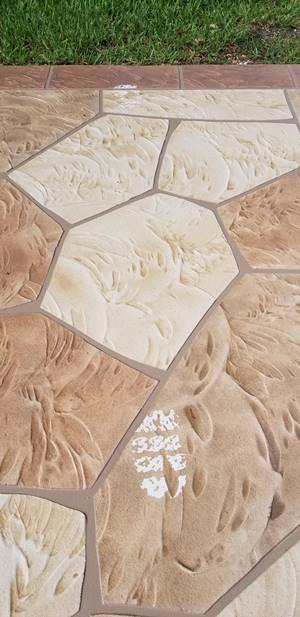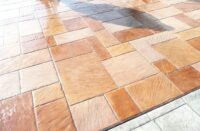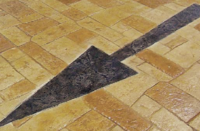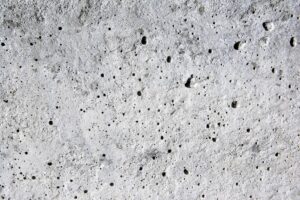Question: Why do my car tires pull the sealant off my patterned concrete drive?
The issue of car tires pulling sealer from concrete is known as “hot-tire pickup.” The initial conclusion most people make when they hear “hot-tire pickup” is that a hot tire is melting the sealer and causing it to peel off the concrete. While heat is a factor in the process, the sealer is not melting. Like most sealer issues, hot-tire pickup comes down to sealer type, and more importantly, sealer adhesion — the bond between the sealer and concrete substrate.
As a car tire runs on the street during normal use, the temperature of the rubber increases. To experience this, feel your car tire in the morning before you drive, then again after you arrive at your destination. The heat generated from normal use causes the tire to expand slightly. When you stop driving and the tire cools, it shrinks back to normal size. This contraction in size puts pressure on the surface the tire is resting on. That pressure is the force that causes hot-tire pickup. As the tire shrinks, it pulls the sealer off the concrete.

This is why you can see the tire treads in the concrete with most hot-tire pickup failures — the tires only pulled the sealer off where they were physically touching the surface.
But that is not the whole story. If that were the case, every sealed concrete driveway would experience hot-tire pickup, and we all know that is not the case. In fact, the number of hot-tire pickup issues is quite small when you consider the total square feet of sealed concrete that exists. So if all tires contract when they cool, why don’t all sealed driveways with cars parked on them exhibit hot-tire pickup? This has to do with the type of sealer on the driveway and how well it has adhered to the concrete.
While all sealers have the ability to withstand hot tires without failure, some sealers are better suited to resisting hot-tire pickup than others. Acrylic sealers perform worse than epoxies and polyurethanes when it comes to resisting hot-tire pickup. This is because acrylic sealers do not exhibit the same degree of cross-linking that epoxies and polyurethanes do. Cross-linking is a chemical process in which the polymer chains of the sealer resin form bonds among themselves. Highly cross-linked sealers are more durable, more chemical-resistant and stronger overall than those with minimal cross-linking. It only makes sense that epoxies, polyurethanes and polyureas, which are all highly cross-linked, resist hot-tire pickup much better than acrylics.
The downside to using epoxies and polyurethanes is that the cross-linking properties that make them so durable also make them mostly impermeable and not good candidates for exterior sealing applications. The impermeability does not allow these highly cross-linked sealers to breathe very well, which in turn makes them more prone to trapping moisture and turning white in exterior applications.
Since most driveways are outside, this leaves us with acrylics. That is why 99 percent of exterior decorative concrete is sealed with an acrylic sealer. Not to mention the fact that epoxies and polyurethanes cost two or three times more than acrylic sealers.
The most important factor in hot-tire pickup is sealer adhesion to the substrate. If you get proper adhesion between the sealer and the concrete, hot-tire pickup is not an issue, even when using acrylic sealers. In most hot-tire pickup failures, the sealer bond to the concrete is weak, and the force of the contracting tire is enough to peel the sealer from the concrete. This is another reason to properly prepare all substrates prior to sealing, and to apply sealers in thin coats to minimize the amount of sealer on the surface. Remember, “thin to win” when it comes to sealing concrete!
Also, keep in mind that the type of tires on the vehicle can play a significant role in the severity of hot-tire pickup. High-performance tires found on many cars and trucks these days are soft. The chemicals in the tire that make them soft (plasticizers) can leach out of tires and actually make the tire more prone to sticking to the sealer.
This piece of information is good to know but not very practical, since asking a homeowner to buy lower-quality tires to prevent hot-tire pickup is not something I would recommend. If you do have a driveway with hot-tire pickup, the best response involves stripping the sealer, touching up the color, properly cleaning and preparing the surface, and resealing. I recommend using low solids (below 20 percent) and limiting the application to one coat of sealer.

Questions From Readers
Question
Why do my truck tires pull the color off the driveway?
Answer from Concrete Decor
The problem you’re experiencing with the tires pulling your coating off the surface of your driveway has to do with expansion/contraction. Hot tires are parked on the surface, cool off and retract slightly. Because of the weight of the vehicle, the tires are pulling the coating off during that period of contraction.
You may consider finding some kind of perforated plastic pads that you can position your tires on each time you park so they’re cooling off on a surface other than your sealed concrete. The problem could also be associated with the type of sealer that was applied or how long ago the sealer was applied that is affecting your finish.















